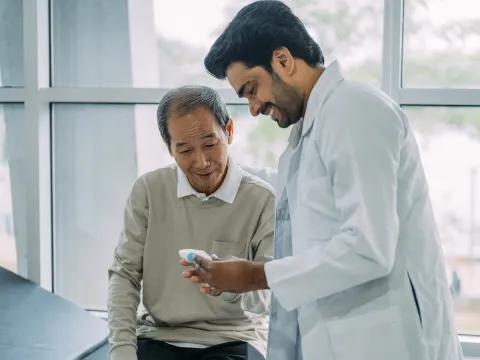- AdventHealth

Choose the health content that’s right for you, and get it delivered right in your inbox.
The COVID-19 pandemic changed heart health care forever, specifically in the way care is managed and delivered. While masking up and social distancing was required to prevent the spread of the disease, a separation was created between family and friends. But it also had a significant impact on patient-physician relationships.
The innovative use of telemedicine was quickly adopted and narrowed that gap. Suddenly a cardiologist’s office could be anywhere, at any time, if the patient has a device to log in to a virtual visit. Now, this care method is considered conventional rather than a passing novelty, and any stigma surrounding telemedicine has disappeared as both patients and heart care providers experience its convenience and effectiveness.
One important innovation is the shift toward wearable technology that allows heart patients to be monitored by their physician virtually, even while at home. We’re here to explain what wearables are, how they’re improving heart care and why more cardiologists are encouraging them for their patients.
What Are Wearables?
With technology and medicine colliding in many ways, more work was needed to bridge the patient-provider gap. For cardiovascular care in particular, wearable technology helped shift the status quo away from the physician’s office into a virtual care center. The high-tech devices, including wearables and body sensors, can provide real-time data on a patient’s metrics, including blood pressure, oxygen, heart rates and even weight with complex algorithms that are fed into an electronic health record (EHR).
Some devices can be direct-to-consumer with no prescription needed. These include fitness trackers like the Apple Watch. Others are considered medical grade, with wearable devices including digital blood pressure cuffs, EKG monitoring and arrhythmia monitoring systems.
How Wearables Are Advancing Heart Care
Cardiologists are starting to see wearables as the balance between traditional medicine and the future of health care. With data reporting on such measures as heart rate, blood pressure and physical activity, physicians can care for patients while the patient can stay home. One of the big goals of wearables is to meet patients wherever they are to deliver care, as well as have them take a more proactive role in their heart care.
Wearables are particularly valuable for remote patient monitoring (RPM), as hospitals seek to lower the rate of hospital readmissions since they can monitor patients related to acute hospitalizations or post-procedures.
In certain conditions such as heart failure, wearables allow physicians to ask questions about the stability of their patients, or to see if the trajectory of their condition improved or worsened post-hospitalization.
Another important factor of wearables is that the information can be shared between patient and caregiver, so that each has a clear understanding of the health patterns patients undergo. Positive impacts on the patients themselves, where data can be collected using the devices, include a physician’s better understanding of how patients are doing and what challenges they may be facing.
Leading-Edge Cardiac Care From the Heart
At AdventHealth, we have the heart to care for your emotional and spiritual needs with compassion, and the backbone to provide leading-edge treatments and technology to keep your heart strong and healthy.
To learn more about our comprehensive heart care, visit us here. You deserve to be cared for in body, mind and spirit.



